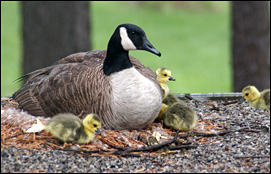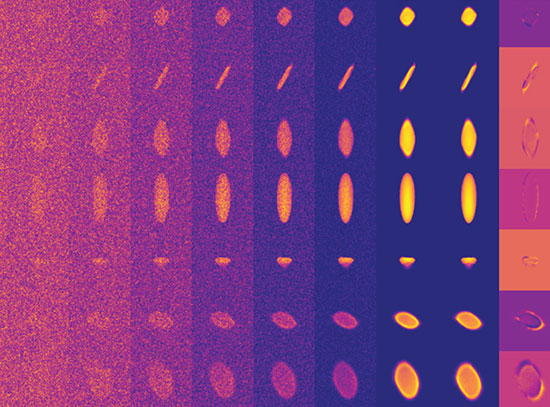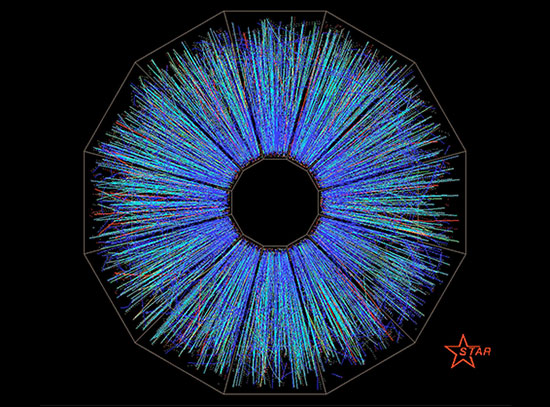Brookhaven Lab Releases 2003 Environmental Report
November 22, 2004
UPTON, NY - The U.S. Department of Energy's Brookhaven National Laboratory has issued its 2003 Site Environmental Report. Report highlights include the Lab's continued expansion of pollution prevention initiatives, re-certification of its environmental management system, and reduced environmental effluents and emissions. The document is available online.

A Canadian goose with its goslings photographed on the Brookhaven site.
The Site Environmental Report is prepared annually to summarize the status of the Laboratory's environmental programs and performance, including steady progress toward cleaning up the site and fully integrating environmental stewardship into all facets of the Laboratory's mission. These cleanup and integration efforts are major commitments for Brookhaven, one of ten national laboratories owned and funded by the Department of Energy (DOE).
Brookhaven maintains a comprehensive environmental monitoring program to ensure protection of human health and the environment. This program monitors potential pathways of exposure, measures potential environmental impacts from Laboratory operations, and provides data to evaluate compliance with applicable regulatory limits. Environmental program highlights from 2003 include the following:
• Since 1999, Brookhaven's pollution prevention programs, recycling programs, and conservation initiatives saved more than $1.5 million and supported the recycling or reuse of more than 2.3 million pounds of industrial materials. In 2003, BNL invested approximately $96,000 in newly funded pollution prevention projects, with an annual anticipated savings of $88,000, and an average payback period of 1.2 years.
• In July 2003, an environmental management system surveillance audit determined that Brookhaven remains in conformance with the globally recognized ISO 14001 standard. ISO 14001 requires an organization to identify potential environmental impacts and establish controls needed to minimize impacts, to monitor and communicate environmental performance, and to establish a formal process for continually improving the system. Brookhaven was the first Long Island-based operation and the first DOE Office of Science facility to achieve this accreditation.
• In 2003, the dose to a hypothetical member of the public exposed to the maximum level of radiation due to Laboratory air emissions was 0.06 millirem (mrem), or less than 0.02 percent of the average annual natural background level of radiation (approximately 300 mrem on Long Island) and well below the 10-mrem limit set by the U.S. Environmental Protection Agency (EPA) under the Clean Air Act. This dose is calculated for a hypothetical individual residing at the Laboratory boundary 24 hours a day for the entire year. The EPA regulates Brookhaven's radiological air emissions.
• Monitoring showed that deer and fish on and near the site still contain low levels of Brookhaven-related radionuclides. The calculated maximum hypothetical radiation doses for a person eating locally caught deer and fish were estimated at 2.2 mrem and 0.19 mrem, respectively. The annual dose from deer meat is based on a consumption estimate of 64 pounds per person, and the dose due to fish is based on a consumption estimate of 15 pounds per person. Hunting is not allowed on the Brookhaven site, and the New York State Department of Health (NYSDOH) has concluded that no restrictions on hunting or consumption of deer taken near Brookhaven are needed. NYSDOH has also evaluated data on Peconic River fish and concluded that the existing general fish advisory for all N.Y. State ponds and rivers, including the Peconic, is sufficient. This general advisory is to protect residents from eating large amounts of fish that have not been tested or may contain unidentified contaminants, and recommends that no more than one meal (1/2 pound) per week of fish should be consumed from any freshwater location in the state.
• In 2003, waste water discharges from the Laboratory's sewage treatment plant, a discharge point regulated by the New York State Department of Environmental Conservation (NYSDEC), complied with state permit limits in greater than 99 percent of the samples taken. The one exception involved a high iron reading in a single sample. In terms of radiological releases, the average tritium concentration during 2003 was 166 picocuries per liter, or less than one percent of the EPA drinking water standard of 20,000 picocuries per liter (a picocurie is a measurement of radioactivity equivalent to one-trillionth of a curie). Total tritium releases to the Peconic River were slightly higher than in 2003 due to activities at the High Flux Beam Reactor in preparation for its future decommissioning. For surface-water samples, all water-quality measurements were consistent with off-site control locations (areas not influenced by Brookhaven operations).
• Areas of the Laboratory site where past activities have caused groundwater, soil, and sediment contamination continued to undergo monitoring and cleanup in 2003. Program highlights included the start of a successful effort to remove contaminated filters from belowground air ducts in the Brookhaven Graphite Research Reactor using remotely operated equipment. Also during 2003, seven groundwater remediation systems removed 510 pounds of volatile organic compounds and returned approximately 1.3 billion gallons of clean water to the aquifer. Since December 1996, Brookhaven has removed 4,156 pounds of volatile organic compounds by treating nearly 6.8 billion gallons of groundwater. Nine new groundwater systems are in design or construction phase, and all will be operational by 2005. Environmental restoration at the Laboratory is conducted under the oversight of NYSDEC, EPA, and DOE, and in cooperation with the Suffolk County Department of Health Services.
• In 2003, Brookhaven worked with the Upton Ecological and Research Reserve's Technical Advisory Group, regulatory agencies, and other stakeholders to develop a comprehensive, ecosystem-based natural resource management plan and approve funding for several research projects. The 530-acre reserve, which makes up 10 percent of the Laboratory's property and is located within the core preservation area of the Pine Barrens, protects a unique ecosystem of forests and wetlands that provides a habitat for plants, mammals, birds, reptiles, and amphibians. Highlights for 2003 include the discovery of the northern redbellied snake, a species not reported on Long Island in 60 years, and research into the orange striped oakworm, a species capable of defoliating large areas of the abundant oak forests that make up much of the Long Island ecosystem.
Brookhaven has published site environmental reports each year from 1962 to 1966 and from 1971 to 2003. Summary reports for the years 1947 to 1961 and 1967 to 1970 are also available. Data summarized in the 2003 report were obtained through testing performed by state-certified Brookhaven Lab or independent laboratories, the Suffolk County Department of Health Services, NYSDOH, and NYSDEC. To obtain copies of a summary booklet and an accompanying CD containing the full report, call (631) 344-3711 or visit a public library near Brookhaven.
2004-10247 | INT/EXT | Newsroom









